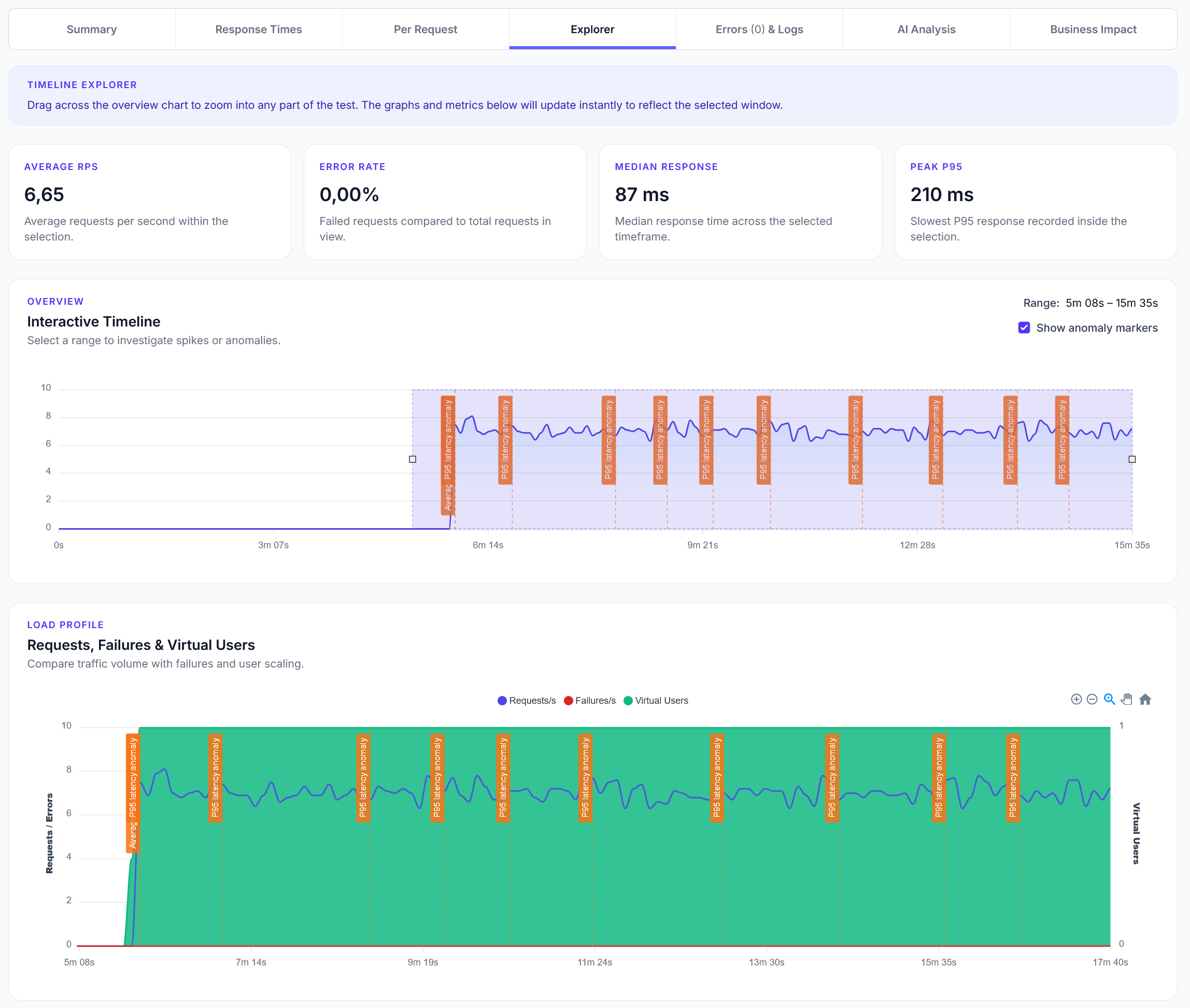
Explorer reports addition
We have added a new Explorer feature to reports, with a timeline scrubber and easy anomaly detection.
Test your application's performance across different geographic regions to ensure consistent user experience worldwide
LoadForge can record your browser, graphically build tests, scan your site with a wizard and more. Sign up now to run your first test.
Test your application's performance across different geographic regions to ensure consistent user experience worldwide. This locustfile simulates users from various global locations accessing your services.
from locust import HttpUser, task, between
import random
import time
import json
from datetime import datetime, timezone
class MultiRegionUser(HttpUser):
"""Simulate users from different geographic regions"""
wait_time = between(1, 3)
def on_start(self):
"""Initialize region-specific configuration"""
# Simulate different regional characteristics
self.region_profiles = {
'us_east': {
'timezone': 'America/New_York',
'language': 'en-US',
'currency': 'USD',
'expected_latency': 50, # ms baseline
'peak_hours': [9, 10, 11, 14, 15, 16]
},
'us_west': {
'timezone': 'America/Los_Angeles',
'language': 'en-US',
'currency': 'USD',
'expected_latency': 80,
'peak_hours': [9, 10, 11, 14, 15, 16]
},
'europe': {
'timezone': 'Europe/London',
'language': 'en-GB',
'currency': 'EUR',
'expected_latency': 120,
'peak_hours': [8, 9, 10, 13, 14, 15]
},
'asia_pacific': {
'timezone': 'Asia/Singapore',
'language': 'en-SG',
'currency': 'SGD',
'expected_latency': 200,
'peak_hours': [9, 10, 11, 14, 15, 16]
}
}
# Select random region profile
self.current_region = random.choice(list(self.region_profiles.keys()))
self.profile = self.region_profiles[self.current_region]
# Set region-specific headers
self.client.headers.update({
'Accept-Language': self.profile['language'],
'X-User-Region': self.current_region,
'X-Currency': self.profile['currency'],
'X-Timezone': self.profile['timezone']
})
# Track latency measurements
self.latency_measurements = []
print(f"User initialized for region: {self.current_region}")
@task(3)
def test_api_latency(self):
"""Test API response times and validate against regional expectations"""
start_time = time.time()
with self.client.get(
"/api/v1/data",
name=f"API Latency - {self.current_region}",
catch_response=True
) as response:
latency = (time.time() - start_time) * 1000 # Convert to ms
self.latency_measurements.append(latency)
if response.status_code == 200:
# Validate latency against regional expectations
expected_max = self.profile['expected_latency'] * 2 # Allow 2x baseline
if latency <= expected_max:
response.success()
print(f"Good latency from {self.current_region}: {latency:.1f}ms")
else:
response.failure(f"High latency from {self.current_region}: {latency:.1f}ms (expected < {expected_max}ms)")
else:
response.failure(f"API request failed: {response.status_code}")
@task(2)
def test_cdn_performance(self):
"""Test CDN content delivery performance"""
# Test different types of content
content_types = [
{'path': '/static/images/hero.jpg', 'type': 'image'},
{'path': '/static/css/main.css', 'type': 'css'},
{'path': '/static/js/app.js', 'type': 'javascript'},
{'path': '/api/v1/config.json', 'type': 'json'}
]
content = random.choice(content_types)
start_time = time.time()
with self.client.get(
content['path'],
name=f"CDN {content['type']} - {self.current_region}",
catch_response=True
) as response:
download_time = (time.time() - start_time) * 1000
if response.status_code == 200:
# Check for CDN headers
cdn_headers = ['X-Cache', 'CF-Cache-Status', 'X-Served-By', 'X-CDN']
cdn_hit = any(header in response.headers for header in cdn_headers)
if cdn_hit:
print(f"CDN hit for {content['type']} from {self.current_region}: {download_time:.1f}ms")
response.success()
else:
print(f"CDN miss for {content['type']} from {self.current_region}: {download_time:.1f}ms")
response.success() # Still successful, just noting CDN status
else:
response.failure(f"CDN content failed: {response.status_code}")
@task(2)
def test_regional_content(self):
"""Test region-specific content delivery"""
regional_endpoints = [
f"/api/v1/content/regional?region={self.current_region}",
f"/api/v1/pricing?currency={self.profile['currency']}",
f"/api/v1/localization?lang={self.profile['language']}"
]
endpoint = random.choice(regional_endpoints)
with self.client.get(
endpoint,
name=f"Regional Content - {self.current_region}",
catch_response=True
) as response:
if response.status_code == 200:
try:
data = response.json()
# Validate region-specific content
if 'currency' in data and data['currency'] == self.profile['currency']:
print(f"Correct currency for {self.current_region}: {data['currency']}")
if 'language' in data and data['language'] == self.profile['language']:
print(f"Correct language for {self.current_region}: {data['language']}")
response.success()
except json.JSONDecodeError:
response.success() # Content might not be JSON
else:
response.failure(f"Regional content failed: {response.status_code}")
@task(1)
def test_regional_failover(self):
"""Test regional failover mechanisms"""
# Simulate accessing primary and backup regional endpoints
endpoints = [
f"/api/v1/health/region/{self.current_region}",
f"/api/v1/status/regional"
]
for endpoint in endpoints:
with self.client.get(
endpoint,
name=f"Regional Failover - {self.current_region}",
catch_response=True
) as response:
if response.status_code == 200:
try:
health_data = response.json()
if health_data.get('status') == 'healthy':
print(f"Regional health check passed for {self.current_region}")
response.success()
break # Primary region is healthy
else:
print(f"Regional health degraded for {self.current_region}")
continue # Try backup
except json.JSONDecodeError:
response.success() # Health check might return simple text
break
else:
print(f"Regional endpoint failed: {response.status_code}")
continue # Try next endpoint
def on_stop(self):
"""Report latency statistics for this region"""
if self.latency_measurements:
avg_latency = sum(self.latency_measurements) / len(self.latency_measurements)
min_latency = min(self.latency_measurements)
max_latency = max(self.latency_measurements)
print(f"Region {self.current_region} latency stats:")
print(f" Average: {avg_latency:.1f}ms")
print(f" Min: {min_latency:.1f}ms")
print(f" Max: {max_latency:.1f}ms")
print(f" Expected baseline: {self.profile['expected_latency']}ms")
class RegionalLoadPatternUser(MultiRegionUser):
"""Simulate realistic regional load patterns based on business hours"""
def on_start(self):
super().on_start()
# Adjust request frequency based on regional business hours
current_hour = datetime.now().hour
if current_hour in self.profile['peak_hours']:
self.wait_time = between(0.5, 1.5) # Higher frequency during peak
print(f"Peak hours for {self.current_region} - increased load")
else:
self.wait_time = between(2, 5) # Lower frequency during off-peak
print(f"Off-peak hours for {self.current_region} - reduced load")
@task(4)
def simulate_business_hours_activity(self):
"""Simulate typical business hours activity patterns"""
current_hour = datetime.now().hour
if current_hour in self.profile['peak_hours']:
# Peak hours - more intensive operations
operations = [
'/api/v1/dashboard',
'/api/v1/reports/generate',
'/api/v1/transactions',
'/api/v1/analytics'
]
else:
# Off-peak - lighter operations
operations = [
'/api/v1/status',
'/api/v1/notifications',
'/api/v1/settings'
]
operation = random.choice(operations)
with self.client.get(
operation,
name=f"Business Hours Activity - {self.current_region}",
catch_response=True
) as response:
if response.status_code == 200:
response.success()
else:
response.failure(f"Business hours operation failed: {response.status_code}")
Update these settings for your multi-region testing:
# Regional Configuration
REGIONS = {
'us_east': {'timezone': 'America/New_York', 'language': 'en-US', 'currency': 'USD'},
'us_west': {'timezone': 'America/Los_Angeles', 'language': 'en-US', 'currency': 'USD'},
'europe': {'timezone': 'Europe/London', 'language': 'en-GB', 'currency': 'EUR'},
'asia_pacific': {'timezone': 'Asia/Singapore', 'language': 'en-SG', 'currency': 'SGD'}
}
# Latency Expectations (milliseconds)
EXPECTED_LATENCY = {
'us_east': 50,
'us_west': 80,
'europe': 120,
'asia_pacific': 200
}
LoadForge allows you to select specific DigitalOcean regions for your load generators:
This locustfile provides comprehensive multi-region testing capabilities, leveraging LoadForge's DigitalOcean region selection to simulate realistic global user patterns and validate geographic performance consistency.